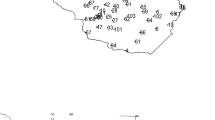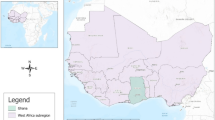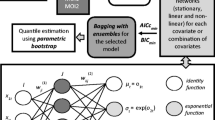Abstract
Annual maxima of daily rainfall data dating from 1901 to 2003 are modeled for fourteen locations in West Central Florida. The generalized extreme value (GEV) distribution is fitted to data from each location. The location parameter of the GEV is formulated as a function of time to adequately describe the extremes of rainfall and to predict their future behavior. We find evidence of non-stationarity in the form of trends for eight of the fourteen locations considered. We quantify the change in extreme rainfall for each location and provide return levels for the years 2010, 2020, 2050 and 2100. We also derive estimates of return levels for daily rainfall and provide a classification of the fourteen locations based on the degree of severity of these estimates. This paper provides the first application of extreme value distributions to rainfall data specifically from Florida.
Similar content being viewed by others
References
Adamowski, K. and Bougadis, J.: 2003, ‘Detection of trends in annual extreme rainfal’, Hydrol. Process. 17, 3547–3560.
Aronica, G., Cannarozzo, M., and Noto, L.: 2002, ‘Investigating the changes in extreme rainfall series recorded in an urbanised area’, Water Sci Technol 45, 49–54.
Cleveland, W. S.: 1979, ‘Robust locally weighted regression and smoothing scatterplots’, J. Am. Stat. Assoc. 74, 829–836.
Cleveland, W. S.: 1981, ‘LOWESS: A program for smoothing scatterplots by robust locally weighted regression’, Am. Stat. 35, 54.
Coles, S. G.: 2001, An Introduction to Statistical Modeling of Extreme Values, Springer, New York.
Conover, W. J.: 1971, Practical Nonparametric Statistics, Wiley, New York.
Crisci, A., Gozzini, B., Meneguzzo, F., Pagliara, S., and Maracchi, G.: 2002, ‘Extreme rainfall in a changing climate: Regional analysis and hydrological implications in Tuscany, Hydrol. Process. 16, 1261–1274.
Farago, T. and Katz, R.: 1990, ‘Extremes and design values in climatology’, World Meteorological Organization, WCAP-14, WMO/TD-No. 386.
Fisher, R. A. and Tippett, L. H. C.: 1928, Limiting forms of the frequency distribution of the largest or smallest member of a sample’, Proc. Camb. Phil. Soc. 24, 180–290.
Galambos, J.: 1987, The Asymptotic Theory of Extreme Order Statistics (2nd ed.), Krieger, Malabar, Fl.
Gershunov, A.: 1998, ‘ENSO influence on intraseasonal extreme rainfall and temperature frequencies in the contiguous United States: Implications for long-range predictability’, J. Clim. 11, 3192–3203.
Good, P. I.: 2001, Resampling Methods: A Practical Guide to Data Analysis, Birkhauser, Boston, Cambridge, MA.
Gumbel, E. J.: 1958, Statistics of Extremes, Columbia University Press, New York.
Haylock, M. and Nicholls, N.: 2000, ‘Trends in extreme rainfall indices for an updated high quality data set for Australia, 1910–1998’, Int. J. Climatol. 20, 1533–1541.
Hosking, J. R. M., Wallis, J. R., and Wood, E. F.: 1985, ‘Estimation of the generalized extreme value distribution by the method of probability weighted moments’, Technometrics 27, 251– 261.
Jenkinson, A. F.: 1955, ‘The frequency distribution of the annual maxima (or minima) values of meteorological elements’, Q. J. Royal Meteorol. Soc. 81, 158–171.
Kotz, S. and Nadarajah, S.: 2000, Extreme Value Distributions: Theory and Applications, Imperial College Press, London.
Koutsoyiannis, D. and Baloutsos, G.: 2000, ‘Analysis of a long record of annual maximum rainfall in Athens, Greece, and design rainfall inferences’, Natural Hazards 22, 29– 48.
Nguyen, V. T. V., Nguyen, T. D., and Ashkar, F.: 2002, ‘Regional frequency analysis of extreme rainfalls’, Water Sci. Technol. 45, 75–81.
Pagliara, S., Viti, C., Gozzini, B., Meneguzzo, F., and Crisci, A.: 1998, ‘Uncertainties and trends in extreme rainfall series in Tuscany, Italy: Effects on urban drainage networks design’, Water Sci. Technol. 37, 195–202.
Parida, B. P.: 1999, ‘Modelling of Indian summer monsoon rainfall using a four-parameter Kappa distribution’, Int. J. Clim. 19, 1389–1398.
Park, J. S. and Jung, H. S.: 2002, ‘Modelling Korean extreme rainfall using a Kappa distribution and maximum likelihood estimate’, Theor. Appl. Climatol. 72, 55–64.
Park, J. S., Jung, H. S., Kim, R. S., and Oh, J. H.: 2001, ‘Modelling summer extreme rainfall over the Korean peninsula using Wakeby distribution’, Int. J. Clim. 21, 1371–1384.
Prescott, P. and Walden, A. T.: 1980, ‘Maximum likelihood estimation of the parameters of the generalized extreme-value distribution’, Biometrika 67, 723–724.
Rakhecha, P. R. and Soman, M. K.: 1994, ‘Trends in the annual extreme rainfall events of 1 to 3 days duration over India’, Theor. Appl. Clim. 48, 227–237.
Rao, C. R.: 1973, Linear Statistical Inference and Its Applications (2nd ed.), Wiley, New York.
Royston, J. P.: 1982, ‘An extension of Shapiro and Wilk’s W test for normality to large samples’, Appl Stat. 31, 115–124.
Schmidt, N., Lipp, E. K., Rose, J. B., and Luther, M. E.: 2001, ‘ENSO influences on seasonal rainfall and river discharge in Florida’, J. Clim. 14, 615–628.
Segal, M., Pan, Z. T., and Arritt, R. W.: 2002, ‘On the effect of relative timing of diurnal and large-scale forcing on summer extreme rainfall characteristics over the central United States’, Mont. Weather Revi. 130, 1442–1450.
Silverman, B. W.: 1986, Density Estimation for Statistics and Data Analysis, Chapman and Hall, London.
Wald, A.: 1943, ‘Tests of statistical hypotheses concerning several parameters when the number of observations is large’, Trans. Am. Math. Soci. 54, 426–483.
Withers, C. S. and Nadarajah, S.: 2000, ‘Evidence of trend in return levels for daily rainfall in New Zealand’, J. Hydrol. (NZ) 39, 155–166.
Yuan, M. and Duchon, C. E.: 2001, ‘Estimation of daily area-average rainfall in central Florida using arithmetic averaging and kriging’, Phys. Geog. 22, 42–58.
Author information
Authors and Affiliations
Corresponding author
Rights and permissions
About this article
Cite this article
Nadarajah, S. Extremes of Daily Rainfall in West Central Florida. Climatic Change 69, 325–342 (2005). https://doi.org/10.1007/s10584-005-1812-y
Received:
Revised:
Issue Date:
DOI: https://doi.org/10.1007/s10584-005-1812-y




